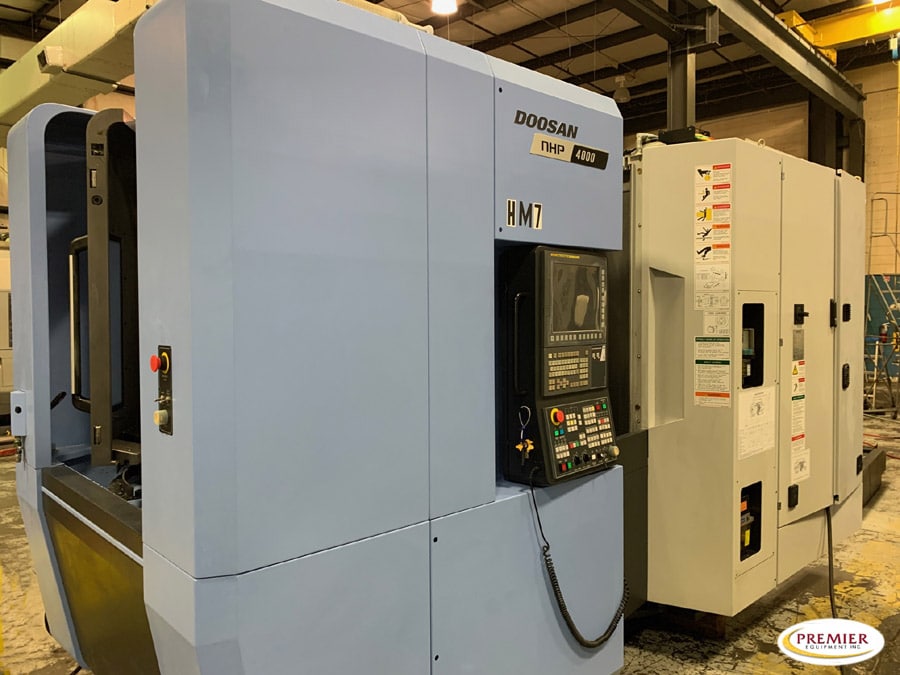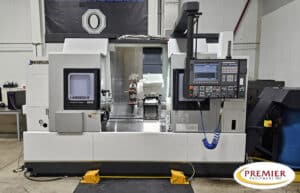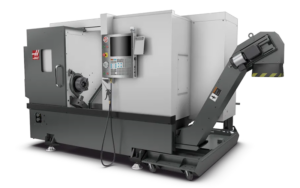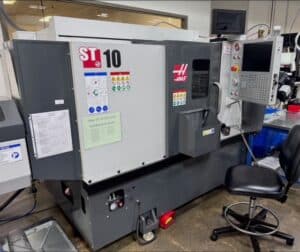Benefits, Costs & What You Need to Know
The definitive resource for manufacturers considering their first horizontal machining center investment
Six months ago, Wilson, who owns a machine shop in Michigan with 35 employees, called us in frustration. Due to their inability to maintain the setup efficiency and tolerances necessary for intricate aluminum transmission housings, his shop was declining $500,000 in automotive work each year. He informed us, “We lose to shops with horizontal machines every time I quote these jobs on our vertical mills.” “But the thought of spending $200,000 on equipment that I don’t fully understand scares me.”
Wilson’s worry is not unique. In addition to offering work that is just not feasible with standard equipment, the Doosan NHP 4000 marks a substantial increase in complexity and capability over traditional vertical machining centers. In our 37 years of assisting shops with these changes, we have witnessed both how the NHP 4000 can revolutionize businesses and how poorly-prepared shops can suffer.
By fusing competitive pricing with Korean engineering quality, the Doosan NHP 4000 horizontal machining center offers outstanding value in the used equipment market, making horizontal machining affordable for mid-sized shops. Although it isn’t the biggest or fastest machine on the market, it strikes a strategic balance between price and capability.
This thorough guide covers every aspect of the Doosan NHP 4000, from operational requirements and total investment costs to technical specifications and practical advantages. Our objective is to assist you in determining whether this machine is a good fit for your shop’s requirements, capabilities, and expansion goals.
Understanding the Doosan NHP 4000: Machine Overview

Doosan’s entry-level horizontal machining center, the NHP 4000, was created to enable shops that previously couldn’t afford the investment to have horizontal machining capabilities. Even though it is marketed as “entry-level,” the machine offers remarkable performance and capability that rivals those of competitors with much higher prices.
Complete Technical Specifications
Work Envelope:
- X-Axis Travel: 24.80 inches (630mm)
- Y-Axis Travel: 23.62 inches (600mm)
- Z-Axis Travel: 24.80 inches (630mm)
- Pallet Size: 15.75″ x 15.75″ (400mm x 400mm)
- Maximum Workpiece Weight: 1,102 lbs (500kg)
- Maximum Workpiece Diameter: 25.59″ (650mm)
Performance Specifications:
- Spindle Motor Power: 22 HP (16.5 kW) continuous
- Spindle Speed Range: 50-10,000 RPM
- Spindle Taper: CAT-40 (HSK available)
- Spindle Positioning: 0.001°
- Rapid Traverse Rate: 1,575 IPM (40 m/min) on all axes
Machine Tool System:
- Tool Storage Capacity: 60 positions standard
- Maximum Tool Weight: 17.6 lbs (8kg)
- Maximum Tool Length: 11.81″ (300mm)
- Maximum Tool Diameter: 4.72″ (120mm)
- Tool Change Time: 2.8 seconds (chip-to-chip)
Positioning Accuracy:
- Positioning Accuracy: ±0.0002″ (±0.005mm)
- Repeatability: ±0.00008″ (±0.002mm)
- Circular Interpolation: ±0.0001″ (±0.003mm)
Machine Construction:
- Machine Weight: 17,637 lbs (8,000kg)
- Floor Space Required: 154″ x 142″ (L x W)
- Machine Height: 102″ (2,590mm)
- Power Requirements: 460V, 3-phase, 50 kVA
Control System
One of the most popular and well-supported CNC controls in the market, the Fanuc 31i-B control system, is normally included with the NHP 4000.
This offers a number of benefits:
- Industry-standard programming compatible with most CAM systems
- Extensive service network with technicians nationwide familiar with Fanuc
- Advanced features including high-speed machining capabilities and network connectivity
- Macro programming support for complex operations
- Conversational programming options for setup and simple operations
Key Benefits of the Doosan NHP 4000
Knowing the NHP 4000’s useful benefits makes the investment seem less daunting and makes it clearer how this machine revolutionizes manufacturing capabilities.
Benefit 1: Dramatic Setup Time Reduction
The Advantage: Horizontal machining centers change the way parts are made by letting you access multiple part faces in one setup. The 400mm pallet system on the NHP 4000 lets the machine index all of its parts without any help from the operator.
Real-World Impact:
- 4-sided machining in single setup eliminates multiple re-chucking operations
- Automatic pallet changers (optional) enable lights-out machining capability
- Tombstone fixtures allow multiple parts per cycle, dramatically improving throughput
- Reduced handling minimizes errors and improves geometric relationships between features
Quantified Results: The NHP 4000 can often finish a typical transmission housing that needs 6 operations on vertical mills in just 1 or 2 operations. This means that setup time is cut by 60–80% and labor costs are cut by a lot for production runs.
Benefit 2: Superior Chip Evacuation
The Advantage: The horizontal spindle orientation uses gravity to naturally move chips away from the cutting area, which stops re-cutting and greatly extends the life of the tool.
Real-World Impact:
- Chips fall away naturally rather than packing around the tool and workpiece
- Coolant flow more effectively flushes chips from the cutting zone
- Tool life improvements of 30-50% are common due to better chip evacuation
- Better surface finishes result from chips not interfering with cutting action
Quantified Results: When shops switch from vertical to horizontal machining for aluminum parts, the cost of tools usually goes down by 25% to 40% per part. The NHP 4000’s big chip conveyor and high-pressure coolant system make the most of this benefit.
Benefit 3: Enhanced Rigidity and Precision
The Advantage: The NHP 4000’s horizontal design makes it stiffer than vertical mills. It has spindle support that uses gravity and a huge box-way construction that can handle cutting forces well.
Real-World Impact:
- Heavier cuts possible without chatter or deflection
- Improved accuracy especially on larger, heavier workpieces
- Better surface finishes due to reduced vibration and chatter
- Longer tool life from stable cutting conditions
Quantified Results: The NHP 4000 keeps its positioning accuracy at ±0.0002″ even when cutting heavy loads, which means that tight-tolerance work always has the same quality. The repeatability of ±0.00008″ makes sure that the geometric relationships between features stay within specifications from one production run to the next.
Benefit 4: Competitive Pricing in the Used Market
The Advantage: Doosan machines are usually 20–30% cheaper than similar Japanese or German horizontal machining centers on the used market. This makes horizontal machining available to more manufacturers.
Real-World Impact:
- Lower entry barrier for shops entering horizontal machining
- Better ROI potential due to lower initial investment
- Comparable capability to machines costing significantly more
- Proven reliability with extensive track record
Market Pricing:
- 2015-2017 NHP 4000: $160,000-$200,000
- 2018-2020 NHP 4000: $200,000-$250,000
- 2021-2023 NHP 4000: $250,000-$320,000
When compared to similar Mazak or Mori Seiki models that are usually 25–40% more expensive for the same age and condition.
Benefit 5: Excellent Build Quality and Reliability
The Advantage: Doosan uses its knowledge of Korean manufacturing to make machines that are as good as Japanese ones but cost less. The NHP 4000 is built to last and is perfect for use in production settings.
Real-World Impact:
- Box-way construction provides superior rigidity and longevity
- Precision components including THK linear guides and quality ball screws
- Robust spindle design handles heavy cutting without premature failure
- Quality assembly results in fewer reliability issues than economy brands
Long-term Value: Premier Equipment’s service records show that NHP 4000 machines can keep working well for more than 15,000 hours if they are properly maintained. Machines that last are made with high-quality materials and a simple design.
Benefit 6: Comprehensive Tooling Capacity
The Advantage: The 60-position tool magazine has a lot of space for complicated parts that need more than one operation, which cuts down on tool changes and speeds up cycle times.
Real-World Impact:
- Complete operations possible without manual tool changes
- Tool families can stay loaded permanently for common work
- Reduced setup time when changing between jobs
- Flexible production enabling lights-out operation
Practical Application: It might take 25 to 35 tools to fully machine a typical automotive transmission housing. The NHP 4000’s 60-position magazine makes this easy, and it also has room for other tools or future growth.
Benefit 7: Fanuc Control System Support
The Advantage: The Fanuc 31i-B control system is one of the most widely supported in North America. This makes it much easier to get help, program it, and train operators.
Real-World Impact:
- Easy technician availability for service and troubleshooting
- CAM system compatibility with extensive post-processor support
- Operator familiarity as many machinists have Fanuc experience
- Training availability through numerous sources
Support Network: Fanuc has hundreds of service centers across the country, and most parts are available the same day. This cuts down on downtime by a huge amount compared to less common control systems.
Benefit 8: Scalable Production Capability
The Advantage: The NHP 4000 is compatible with optional automatic pallet changers (APC), which lets you make things without having to turn on the lights and lets you make more things without having to buy new machines.
Real-World Impact:
- Start with manual operation to minimize initial investment
- Add APC later when production volume justifies automation
- Lights-out capability maximizes equipment utilization
- Future-proof investment grows with production needs
Growth Path: Most shops start with manual pallet loading, then add a 2-pallet APC in 12 to 18 months, and finally add 4 or 6 pallet systems as sales rise. This staged investment strategy spreads costs out over time while gradually building up capabilities.
Total Investment Analysis: What Does It Really Cost?
Knowing the whole financial picture helps you make smart choices and makes sure you have enough money to carry out your objectives.
Machine Acquisition Costs (Used Market)
| Model Years | Price Range | Key Features |
|---|---|---|
| 2015-2017 Models | $160,000 – $200,000 |
|
| 2018-2020 Models | $200,000 – $250,000 |
|
| 2021-2023 Models | $250,000 – $320,000 |
|
Essential Additional Investments
| Investment Category | Cost Range | What’s Included |
|---|---|---|
| Rigging and Installation | $15,000 – $25,000 |
|
| Pallet System | $20,000 – $50,000 |
|
| Tooling Investment | $40,000 – $80,000 |
|
| Fixturing and Workholding | $30,000 – $60,000 |
|
| Training and Startup | $15,000 – $30,000 |
|
| CAM Software (if needed) | $10,000 – $25,000 |
|
Total Investment Summary
| Package Type | Components | Cost Breakdown | Total Investment |
|---|---|---|---|
| Minimum Investment Package |
|
|
$235,000 – $325,000 |
| Recommended Investment Package |
|
|
$340,000 – $485,000 |
| Premium Investment Package |
|
|
$500,000 – $695,000 |
Annual Operating Costs
| Cost Category | Annual Range | What’s Included |
|---|---|---|
| Maintenance and Service | $12,000 – $18,000/year |
|
| Tooling Consumption | $15,000 – $30,000/year |
|
| Utilities and Consumables | $8,000 – $15,000/year |
|
| Total Annual Operating Cost | $35,000 – $63,000 | |
Applications Guide: Where the NHP 4000 Excels
Knowing the best uses for any equipment investment helps you get the most out of them and get the most return on your investment.
Automotive Manufacturing
Ideal Parts:
- Transmission housings and valve bodies
- Differential cases and covers
- Engine blocks and cylinder heads
- Manifolds and intake systems
- Brake calipers and components
Why It Works: Most car parts have complicated internal cavities, multiple faces that need to be machined, and tight tolerances for assembly. The NHP 4000’s 400mm pallet can easily hold most automotive parts and is accurate and repeatable enough for use in production settings.
Aerospace Applications
Ideal Parts:
- Structural brackets and fittings
- Landing gear components
- Engine mounts and supports
- Actuation housings
- Manifolds and fluid control blocks
Why It Works: The NHP 4000 gives aerospace parts the accuracy and dependability they need. The machine’s repeatability of ±0.00008″ meets aerospace tolerance standards, and its wide range of tools makes it possible to do the complex work needed for aircraft parts.
General Manufacturing
Ideal Parts:
- Gearbox housings
- Pump bodies and manifolds
- Hydraulic valve blocks
- Industrial machine components
- Mold components and bases
Why It Works: The NHP 4000 can handle the different types of work that are common in general manufacturing job shops. The 60-tool capacity and strong construction make it possible to make a lot of different things quickly while still keeping the accuracy needed for proper assembly and operation.
Medical Device Components
Ideal Parts:
- Surgical instrument housings
- Implant fixtures and tooling
- Medical device housings
- Precision calibration fixtures
Why It Works: Medical manufacturing requires both accuracy and the ability to do the same thing over and over. The NHP 4000’s precision and Fanuc control documentation meet the validation standards needed for making medical devices.
Making the Decision: Is the NHP 4000 Right for You?
You Should Consider the NHP 4000 If:
Your Work Matches the Profile:
- Multiple parts requiring 4-6 operations on vertical mills
- Complex aluminum or steel components
- Production quantities of 25+ pieces per year
- Parts with tight geometric relationships between features
You Have the Foundation:
- Experienced CNC programmers on staff
- Skilled operators willing to learn horizontal machining
- Production control systems to manage pallet flow
- Financial capacity for complete investment package
You’re Ready for Growth:
- Current capacity limiting ability to quote complex work
- Competitors with horizontal machines winning business
- Customer base requesting capabilities you can’t provide
- Vision for expanding into production work
You Should Wait or Consider Alternatives If:
Preparation Gaps Exist:
- Limited CNC programming experience
- Minimal operator training capabilities
- Lack of capital for complete investment
- Uncertain about work volume to justify investment
Alternative Solutions May Work:
- Current work fits within vertical mill capabilities
- Investing in additional vertical capacity makes more sense
- 3-axis machining meets all customer requirements
- Outsourcing complex work remains more economical
The Strategic Reality
Machine shops become production-ready manufacturers thanks to the Doosan NHP 4000. It’s not a machine for shops just starting out with CNC, but it’s also not too complicated for seasoned shops to use successfully if they prepare.
Success with the NHP 4000 requires:
- Realistic assessment of capability needs
- Adequate investment in complete system (not just the machine)
- Commitment to training and skill development
- Patience during the learning curve (typically 6-12 months to full productivity)
When these factors come together, the NHP 4000 offers outstanding value, increasing the efficiency of existing parts and providing access to previously unattainable work.
Frequently Asked Questions (FAQ)
Q: What is the maximum part size the NHP 4000 can handle? A: The NHP 4000 has a 15.75″ x 15.75″ pallet and a work envelope that measures 24.80″ x 23.62″ x 24.80″ (X/Y/Z). 1,102 pounds is the maximum weight of the workpiece. However, fixturing requirements and part geometry determine the practical limits. In order to make room for tools and fixtures, the majority of parts that fit on the pallet remain under 18″ in any dimension.
Q: How does the NHP 4000 compare to vertical machining centers? A: Parts requiring multiple face machining with precise geometric relationships are well-suited for horizontal machining centers such as the NHP 4000. For complex components, they provide faster setup times, better access to part features, and superior chip evacuation. For flat plate work, simple parts, and shops lacking the funds or volume to support the complexity of horizontal machining, vertical mills continue to be superior.
Q: Can the NHP 4000 handle 5-axis work? A: No, the NHP 4000 is a horizontal machining center with four axes (X, Y, Z, and pallet rotation). It is not capable of complete 5-axis simultaneous machining. You would require a different machine configuration for true 5-axis work.
Q: What materials can the NHP 4000 machine effectively? A: All common manufacturing materials, such as cast iron, titanium, stainless steel, steel, and aluminum, are handled by the NHP 4000. Although very heavy steel roughing may be slower than with machines with 30HP or more spindle power, the 22HP spindle is powerful enough for the majority of applications.
Q: Are there financing options available for used NHP 4000 machines? A: Yes, financing for used CNC equipment is often available. Rates are based on creditworthiness, and terms usually range from three to seven years. As part of the purchasing process, Premier Equipment can assist in setting up equipment loans through its network of financing partners.
Q: What are the annual operating costs? A: Set aside $35,000 to $63,000 per year for utilities/consumables ($8K-15K), tooling consumption ($15K-30K), and maintenance ($12K-18K). Utilization rates and the kinds of materials being machined affect actual costs.
Q: How difficult is it to program a horizontal machining center? A: Compared to vertical mills, horizontal programming necessitates more complexity, mostly in the areas of tool path optimization, collision avoidance, and fixturing design. Within three to six months, skilled CNC programmers usually start producing results. To prevent costly crashes during the learning phase, CAM software with simulation features is crucial.
Q: What CAM software works with the NHP 4000? A: All of the main CAM systems, such as Mastercam, Siemens NX, Fusion 360, Gibbs CAM, and others, are compatible with the NHP 4000’s Fanuc 31i-B control. Fanuc post-processors are offered by the majority of CAM vendors; however, you might require customization for your particular machine configuration and preferences.
Q: How many pallets do I need to run efficiently? A: For manual operation, start with at least four to six pallets. This keeps the machine operating continuously while enabling you to load two to three pallets. Six to twelve pallets offer good flexibility for lights-out operation for automated pallet changers.
Q: Can I add automation later? A: Yes, after initial installation, automatic pallet changers can be added to the NHP 4000 as an optional feature. This makes it possible to reduce the initial investment by beginning with manual operation and then adding automation when production volume warrants the higher cost.



